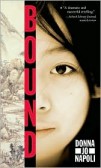Developing readers often know about fairy tales from Disney movies or books their parents read to them. They know the basic parts of the tale. For example, most children could tell you about Cinderella:
Cinderella has a wicked stepmother and two step-sisters. She wants to go to the ball but her stepmother won’t let her. Her fairy godmother steps in and gives Cinderella a beautiful dress and glass slippers but she has to be home before the clock strikes twelve. When she leaves she accidently leaves a glass slipper behind. The prince wants to find her so he has all the girls try on the slipper. He finds Cinderella and the slipper fits so they live happily ever after.
The above section is just the bare bones of the Disney version of Cinderella. What a retelling does is take the child’s view of tales like Cinderella and change it. In Donna Jo Napoli’s novel Bound, a Chinese retelling of Cinderella, Xing Xing is bound to her stepmother and step sister who treat her terribly. This novel has the classic Cinderella elements: the ball, the slippers (albeit not glass) and the prince. Not only is this different because it takes place in China during the Ming Dynasty, but it also doesn’t have a fairy godmother and it incorporates many Chinese elements that make this a unique version of Cinderella. Children reading this book see Cinderella in a different light. This is not the classic fairy tale with magic wands and pumpkins. This is story about a girl in the same exact circumstance as Cinderella, except she doesn’t rely on magic.
This genre allows children to experience beloved fairy tales in new and exciting ways. These retellings are often just as good as the original tales, except they have a new twist to it which makes them unique. Retellings challenge what children already know about the fairy tales and ask the big question “what if…..?” By challenging what children already know we are making them into critical thinkers. If they know a fairy tale one way and are exposed to the same tale except without the magic or in a different era, then we are challenging what they know.
The major caution in this genre is to make sure that what the children are reading is age-appropriate. The “retellings of fairy tales” genre is very trendy right now, not just in literature but in television, with shows like Once upon a Time and Grimm, and movies like Shrek and Happily N’ever After. With this genre being so popular now, it can be easy to find books in this category that are made for an older audience, such as the A Tale of the Five Hundred Kingdom series by Mercedes Lackey. For this reason it is important that the children read books that were meant for them, not adults or teens.

